We
let 'them' speak:
Hot Rod
"The Ford GT ist actually an extension of the concept used in the
original Mustang.."
"Ford engineers went to work on the project and by
early June 1963, the initial design study work had been completed."
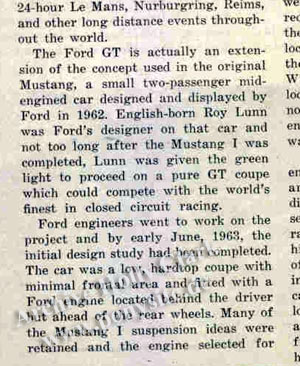
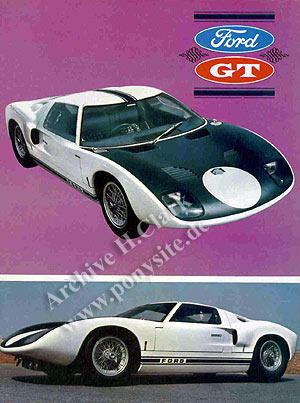
"Unveiled
in 1962, this concept (Mustang I) started development of what became the four-time Le Mans
winning Ford GT40"
Quote from Ford's own website
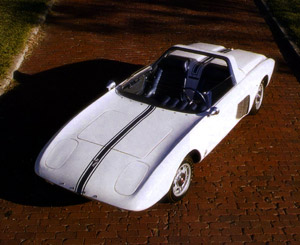
From this view you can see the similarities of
the headlamps. There should be little doubt, what was the base for the GT40
nose design. Phil Clark designed the Mustang I and he worked partially together with Roy Lunn on
body designs that lead to the GT40. (Photo courtesy R.Leffingwell)
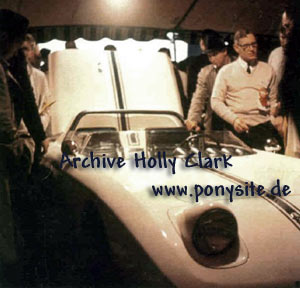
Here shown is Roy Lunn in Watkins Glen 1962 with the Mustang I prototype. (Picture
archive Holly Clark)
Roy Lunn as the Chassis expert and Phil Clark as the Ford stylist worked very close together on
the
Mustang I.
Franco Varani (historian)
..offered us an insight into the current knowledge on the GT40 and Mustang I
separate projects:
"Total Performance program was implemented
at the start of 1963 to run for 4 years until the end of 1966.
After the collapse of the Ferrari talks in May'63, the Total
Performance program was revised and the budget also
revised to include a new GT program (separate from the sportscar Mustang
budget).
The GT was the responsibility of a new department,
the Special Vehicles Activity. The revised proposals
and budget were presented on July 12th '63, rubber stamped between the 15th
& 17th, and implemented on the 19th. This also
included the contract with Lola.
Ford SVA was set up at Lola Cars in Bromley. Because Ford SVA did not have a
corporate identity in Britain, everything was handled
through Lola Cars Ltd whose bank account handled the finances (paid by
Ford of course).
Ford purchased two Lola Mk6GT cars, (complete cars and
not chassis). The original Mk6GT Prototype,
and the first production car GT/1. GT/2 had been sold to
Mecom. Only GT/1 was tested, at Brands Hatch,
Snetterton, Goodwood and finally at Monza. The only changes to the car was
the fitting of a new engine, and a simulation of
Ford's computer designed suspension. Everything else was as Lola built
it.
After the Monza tests, Lola Cars moved to new premises
at Slough in late August '63. As before, the
lease was in the name of Lola and the same arrangements were made for the
use of the Lola bank account.
After Le Mans in June '64, Broadley (Lola), was
released from his contract. He moved next door, and that was when Ford formed Ford Advanced Vehicles, a
wholly owned subsidary of Ford of Britain but
financed by Ford Division (USA).
The first five Ford GT chassis, GT/101 to GT/105, were
built when Lola was involved. After that the
cars are FAV built.
The Mustang I
- There was the full size clay model, the
glassfibre showcar, and the running prototype. The
clay model has a flattened front lip across the front. When they built the
push around glassfibre show car, this flattened edge
was retained. The running prototype bodied by T&B did
not have this. The prototype also had a retractable swivel number plate
holder under the nose. The showcar doesn't. The little
lights under the nose are slightly different on both cars. The showcar
doesn't have them completely recessed, while on the prototype they are.
Most of the publicity shots of the Mustang are the
showcar. The Roy Lunn white paper and the gift
pack Ford handed out also depicts the showcar. The picture of
the two cars together are the running prototype and
the glassfibre show car, (not the nyloc covered clay model). In actuality,
the clay model would have been destroyed in the process of
making the buck, or plug, for the glassfibre
showcar. The same plug was strengthened for shaping the alloy body of the
prototype.
The showcar always had the rear number plate
"00-00-00", which I have yet to see on the running
prototype, which always seems to have a road legal plate.
The pictures on this website which show the car at T&B are
the alloy bodied car, not the glass-fibre car. The
front on picture shows the scallop for the swiveling front number plate.
The other picture shows the alloy spaceframe inside
the car. The showcar never had a chassis, only a
simple platform to mount the body, the glassfibre interior and
dashboard. It had no suspension, engine or drivetrain, and only a simple
steering mechanism so it could be pushed around. At
one point it was pictured on the banking at Dearborn complete with "test"
driver.
The glassfibre car may not have been at T&B, only
the plug and moulds made from the clay model to make the glassfibre car were sent to T&B.
The
pictures of the clay model GT road car were taken on 20th Feb '64. Two days
previously, a revised Special Vehicles Activity budget
estimate calls the car a GT46.
The Total Perfomance presentation
of July 12th '63 suggests the car be called the Thunderbird GT. The GT road
car never got any further,
the budget for '65 lists the car as discontinued.
The GT40 - Launched as the "GT" it was shown
to the British Press on the morning of the April 2nd
at Heathrow Airport Hotel. It was flown overnight to JFK New
York leaving at 03.00am and arriving at 07.00am. It was
shown to the American Press at the Essex House Hotel at South Central Park
on April 3rd. After the presentation it went straight
back to JFK leaving for London at 03.00am on the
April 4th and arriving back in London at 10.00pm the same day.
The pictures you have in your website showing GT/101
being unloaded was when the car arrived at 07.00am.
Ford did not arrange a press conference as such at JFK. The car was pushed
to the back of the airport where nothing else could
get in the shot and pictured by as yet an unknown photgrapher,
probably arranged by whoever was charged with picking the car up. It was
then loaded on to a trailer and taken to Central Park.
Many reports say the car was shown at the New York show.
This was a mistake as the show was on at the same time. When the car
returned to JFK, it was at
night and pitch black.
Thanks to Franco Varani for his status of research 2008.
Important quotes:
Walter Hayes, Director of Ford Advanced Vehicles
"The Mustang I was also the inspiration for the GT40. Freed from
the shackles of organised conformity, Ford decided that Total Performance
meant conquering all the high peaks of the performance world. An
Indianapolis programme was initiated with Colin Chapman and the companys
mighty engine division, and Ford's Advanced Vehicle Studio in Dearborn
produced a prototype - carrying over some hints of the Mustang I - intended
fo Daytona and Le Mans.
Soon a talented, optionated and voluble transatlantic team was formed. John
Wyer - then General Manager of Aston martin - was prevailed upon to direct
the project - which we called Ford Advanced Vehicles Ltd. - from a small,
rented factory on the Slough trading estate. Eric Broadley became involved,
when Ford bought two of his Lola GTs to use as mechanical prototypes during
the development phase and one of these was soon running at Goodwood.
The GT40 was proudly unveiled at the Essex
House Hotel in New York on April 3rd, 1964, the opening day of the New York
Auto Show and two weeks before the Mustang went on sale.
When John Wyer saw the first full-size clay model of the car in the Dearborn
studio he told me he thought it "the most functionally beautiful car I
have ever seen". That opinion was shared by everybody at the
unveiling - although by then John was not pleased. Ford wanted to show the
GT40 - taking the car out of the Slough workshop for only a few days - but
John had just two months to go before Le Mans and was conscious that there
was much testing and development to do. . (Walter Hayes, 1997)
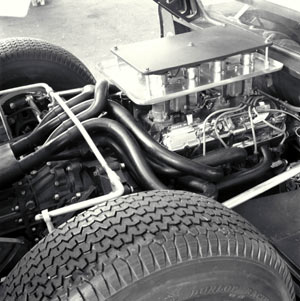
The engine of the GT40 Mark 1, the 4,2 litre
based on a 289cui. (photo Ford)
The facts of the GT40
development:
Courtesy Carmemories.com:
"Through the 1962 Mustang concept, Ford had already developed a
relationship with Roy Lunn, an Englishman who started his career at Ford of
Britain but came to the United States in 1958.
Because Lunn and his team would ultimately develop the GT40, one can think
of Mustang I, a mid-engined sportscar that spawned the classic production
vehicle, as a precursor to GT40 in a philosophical rather than technical
sense. Aluminum-bodied and lightweight, the two-seater was equipped with a
1.7-liter V-4 and some running gear from period Ford Cortinas. Aside from
the mid-engined layout, it bore little resemblance to the Le Mans racers
that would soon make Ford proud, but Mustang I was still essential to the
GT40 program; it proved to Ford management that an international collection
of engineers could form a successful product development team.
After working on the Mustang I, Roy Lunn, along with Ray Geddes and Donald
Frey, turned toward the racing effort. They found that the "Grand
Touring" car Ford conceived to win at Le Mans had much in common with
the new Lola GT, a low-slung coupe developed by Eric Broadley in Slough,
England, not the least of which was the American V-8 mounted amidships – a
rarity for European cars of the time.
Displayed in January 1963, at the London Racing Car Show, the Lola GT was
hardly complete, but it formed an excellent foundation for the development
of the Ford GT40. Essential elements like the monocoque center section, the
broad side sills (they doubled
as fuel tanks) and the aerodynamic profile, made their way to the GT40, and
Broadley, short on funds, was eager to join the Ford team."
Doing Homework
An excellent website of the GT40 History:
http://www.qv500.com
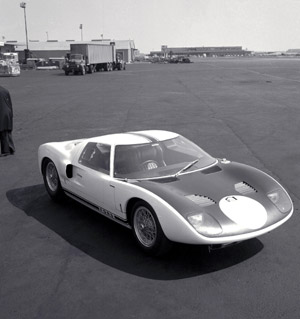
Staged April 2nd, 1964 at the NY airport for "approval by Ford Execs". Ford
Media site pic and quote.

After being transferred in February 1965 to the Essex Ford Design facility (things
moved to UK in Dec. 1964) Phil worked later as well on the MK3 design - at
least occasionally.
But Phil also travelled a lot between the US and UK in the period before his
move. Roy Haynes (who is actually mentioned above in the letter) and John
Fallis got him finally over to the UK.
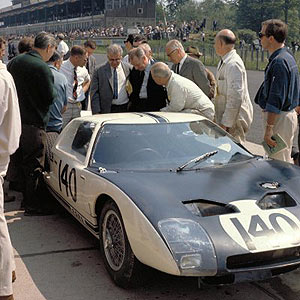
The GT40 Mark I at the Nuerburgring 1964 with
Bruce McLaren and Phil Hill
Pictures courtesy Archive H. Clark/W.
Kohrn
and Ford
except where indicated
|
The
Connection between the Mustang I and the
GT40.
Some historians - like Karl Ludvigsen and Gary Witzenburg - plus a few
well-known journalists from big 60ies magazines have
documented the obvious link of the Mustang I prototype and the first GT40 body
design.
We put a focus on the timeframe of late May 1962 after the
Mustang I roadster project was started ...to early April
64, when the first GT40 was presented to the press and we'll have a look at the body
design only.
Finally we
will add
some interesting information to this research from the personal diarys of somebody who was
a key player in the Ford design studios from the beginning - Phil Clark.
Unfortunately he was totally forgotten and not recorded in the history books - because he died
already in 1968. Some seem to have overwritten history records in fact to get
him deleted. But there are some former colleagues who dared to confirm our
doubts in the records, but cannot speak out for obvious reasons.
If you are interested in the common opinions about the well known
Lola GT link, the popular "PR gig heritage" etc., first read The Autosport Forums Nostalgia
thread
from 2000-2008 (5 pages)
You can actually feel the heat, such a discussion quickly takes.
We are researching the obvious grey zone where Ford was
with its design, when the project was transferred to Lola.
In a Motorsport magazine 2008, Eric Broadley himself says:
"When the initial deal was made, I was going to control the design and
the engineering, but Roy Lunn politiced it away from me. Lunn decided he
wanted a steel monocoque, whereas the MK6 was aluminium. ... Then they
designed a body for the car with no discussion with me, just sent it over to
us. High nose, low tail, hopeless. ... The aerodynamic problems finally got
through to them and they did something about it, but it wasted so much
valuable time."
We're still having a
closer look at it to align notebooks with "official" time schedules.
The results will end up in Hollys book No. 2 - written as a scrap book however
- just as she finds the hints in her Dads books.
Now lets bring up some interesting bits of information.
We've put well-researched material from GT40-historian Franco Varani (researching
for Ronny Spain) in the left column further down for your complete picture, since we don't want
to overlook details we did not have back then. Still we are interested in the body
design process only that came initially from Ford USA..
Have a look at these pics of the Ford GT40 prototype body dated 23.Oct. 1963
at the NVSAAC
webpage

You'll
find those pics at the bottom ot that page..
Two bodies most probably done as well by Troutman and Barnes (but we
will check that again) went to Lola/UK to be fitted to the 2 Lola prototypes,
bought by Ford.
Now you might be even more interested to dive with us into the Ford Design studios
1962 - 1964 and ready
to listen to Holly Clark and her findings
about her Dad's role in Ford design. Those will be mainly part of her second book, but
we will follow along with some sneak previews.
In addition we'll have a first look at the Mustang I designer Phil Clarks relation to Roy Lunn and the GT40
body development. Both of them worked on the Mustang I project and continued
to work together later.
In a first contact Roy Lunn
remembered Phil Clark as one of the young men
working with him.
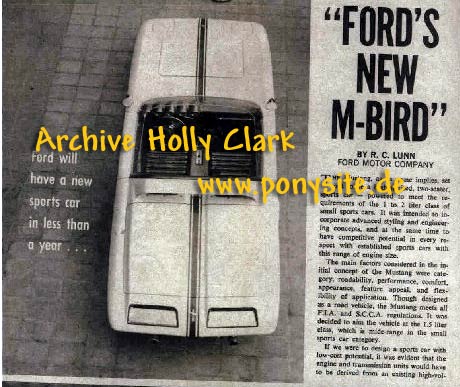
Roy Lunn himself writing about the Mustang
I
"Ford will have a new sports car in less than one year" and
"...the Mustang meets all F.I.A. and S.C.C.A regulations.."
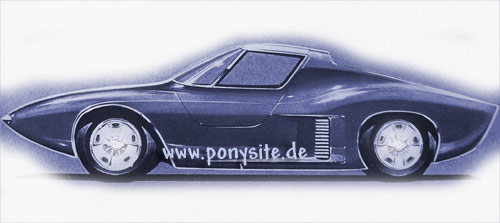
Picture courtesy Gary L. Witzenburg
The concept of a Mustang I coupe (1962) is shown
above.
Note the rear
fender sweeping lines of the GT40 blended with the Mustang I lines. Work on a
Mustang coupe based on the Mustang I prototype started in May 1962 already and
continued through 1962 and 1963.
The Lola MK6, of which Ford
bought 2 cars to use their chassis, was first shown by Eric Broadley in January
1963 at a racing car show.
Ex Aston Martin's
Roy Lunn worked already
as the Project coordinator with chassis engineer Bob Negstad and Designer Phil
Clark on the Mustang I in Dearborn. Together with Phil Remington and a small team
- and for the first time in history designing chassis elements with Fortran
computer aid operated by Chuck Carrig - he was assigned of making the
already designed Mustang I a running
vehicle and not only that. They were studying actual racing cars already from
May 1962 as this picture prooves.
Read more from the
www.autochannel.com
with important quotes on the sports car development.
For the GT40 development Roy
Lunn went back to the
UK in 1963 to work on this project with Ray Geddes and John Wyer at Ford
Advanced Vehicles/Slough.
In May 1963 Ford was turned down by Ferrari. In Le Mans 1963 Ford watched the
Lola MK6 and decided to cooperate with Eric Broadley. Picture
of Lola MK6 at the Nurburgring
Phil Clark initially travelled back and forth between
the US and UK acc. to his records in 1963/64. In December 64 finally the Clarks moved
their stuff to the Essex Design centre and Phil started work there on other
projects like the Capri and Cortina in early
1965.
We would like to differ between the chassis design and the body design and
will have a closer look at both after reviewing relevant publications and
talking to existing contacts plus checking Hollys files.
In fact Karl Ludvigsens Book "The fastest Fords" from 1971 already
shows the direct link and has pictures, drawings and construction
sketches of the Mustang I coupe that led to the GT40. There is little doubt
after paging through that book alone.
(Note: after a few requests from book writers/journalists for additional, Hollys book has
still priority in the publication of course. Unfortunately Holly has suffered
some injuries and health issues during the past years up to 2011, that delay
the publication.).
The MK1s technical development by FAV managed by John Wyer/John Wilment and based on the Lola GT car from
Eric Broadley is certainly a well-known fact, we are focussing first on the
link of the Mustang I prototype, the ongoings in the Ford studios and the original Mustang I team
working on sports cars styling suggestions in the Ford studios including Phil
Clark.
Meanwhile read www.ponysite.de/phil_clark.htm
for further info about the role of Phil in the Advanced design studios.
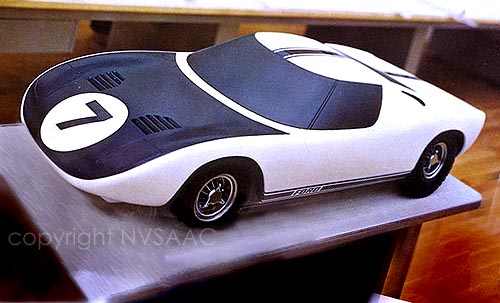
A closer to the final body design scale model in the
Ford design studios. Note that the original Mustang I side scoop is now
missing, while the nose is still maintained.
Roy Lunn:
"We worked 1 year on the GT40 in the US, then one year in the UK,
then
we brought it back to the US"
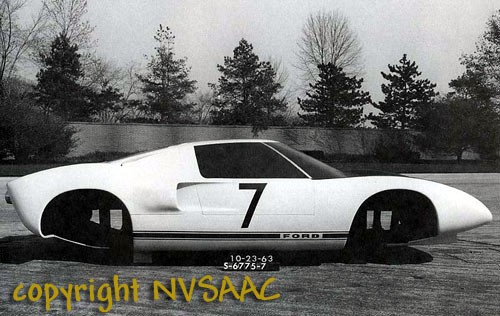
Is this body dated Oct. 23, 1963 really that different from the Mustang I
coupe concept drawing above? You'll be the judge.
"A
string of successes has greeted their appearance. The one illustrated here is
the first Ford GT, designed by the Styling Center in Dearborn and built in
England in 1963/64. At its second appearance it became the holder of the lap
record at the Le Mans 24 Hour race, won first overall at Daytona Continental
and first in class at Sebrig.
The GT Mark 1, a two-seaster competition Gran Turismo, was born from a
remarkable operation of style, engineering and aerodynamics in which neither
men nor means were spared. The result is an extraordinary coupe, only 40 1/2
inches high, equipped with a Cobra V-8 engine, whose performance in the first
round is wiping out European supremacy. Cars like this have flown in
competition at over 200mph and the oustanding win at le Mans also proves its
exceptional strength and absolutely perfect functioning.
Functional aerodynamic form is the basis of the body shape: low front of slim
section and very reduced drag coefficient; uniform side and cut-off tail
incorporating, blended in a single unit, roll bar, rear bumper and curve of
the roof. This semi-monocoque structure is in steel utilizing the roof skin
section as a stressed member; the seats are fixed and form an integral part of
the chassis."
(Quote: G.Bellia on Ford Styling Center at Dearborn)
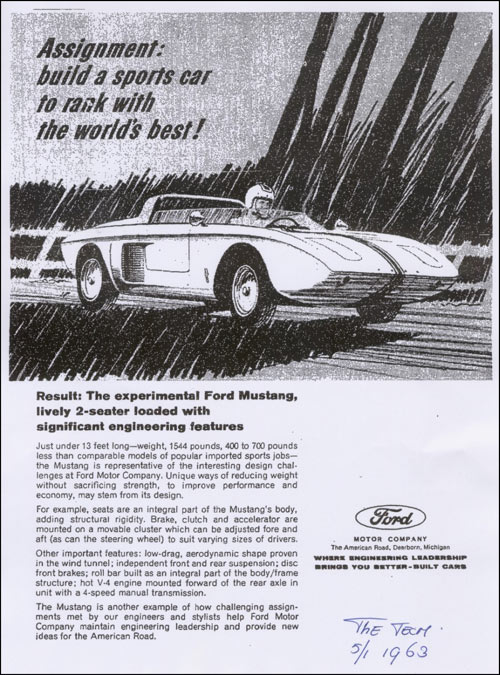
Ford had more in mind, when
picking Clarks idea about the 2-seater sports car - this advertisement points
already to the GT40
Picture courtesy Mark S. Gustavson Archive
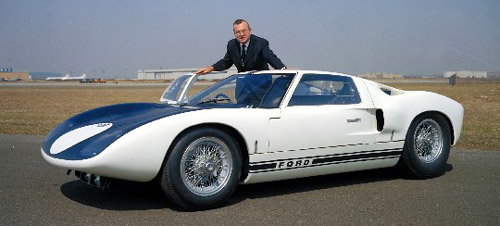
Henry Ford himself did not
want the GT40 name on the stripe, thus it carries only the Ford. This is one
of the two first chassis at the NY airport 2. or 3rd. April 1963
Picture courtesy Ford
One of the GT40 (#101)
with its new Ford designed body went back to the US to be "approved by some
Ford Execs" as Ford puts it on his Motorsport History Media site. Here is it's appearance at the New York airport
April 2nd 1964, to be displayed at the Essex Hotel in New York.
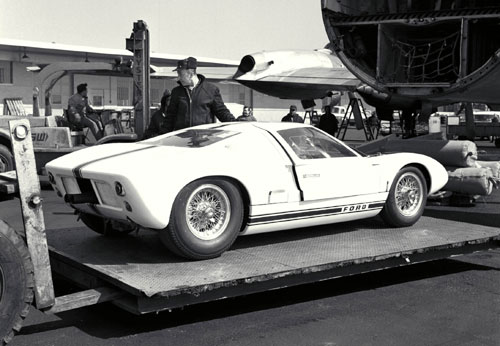
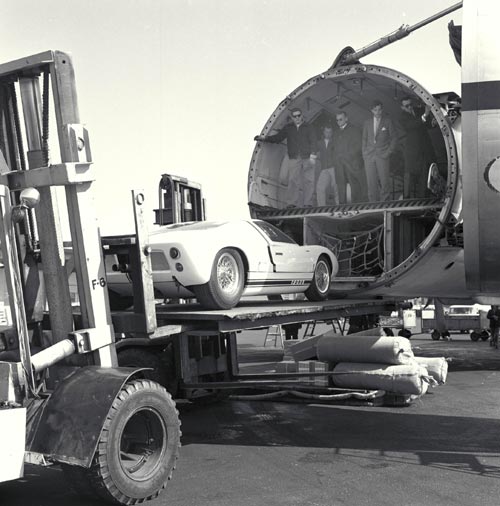
After the approval (Ford Media site quote) it was immediately returned to UK to be
prepared for Le Mans 1964. Ford dates the start of the Le Mans testing on the 16th. April 1964., Ronny
Spain fixes it in his famous GT40 register for the 18th/19th. April.
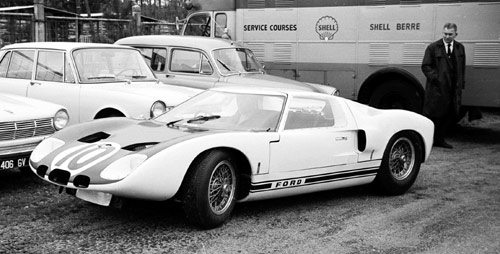
The GT40 still with its original nose in Le Mans 1964 for
testing. Obviously the airstream of the front was a problem, which lead to
several changes during development. Later the nose was changed more radical.
The car wasn't stable at all and got airborn and both cars crashed. A rear
spoiler was added after repair for improved stability and solved the issue.
Still we really wonder wether Ford would continue to use this nose so long for just a
PR gig, as the saying is. We have to assume as of now they did not know
better and had to learn it on the Mulsanne straight... that Le Mans racing is
different than Sebring.
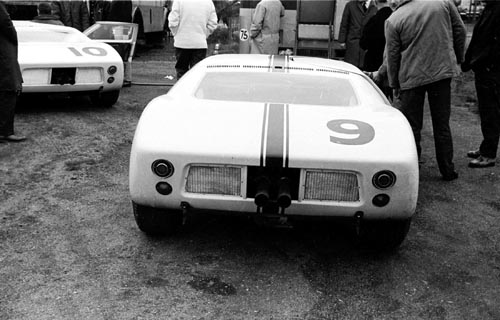
Both GTs #101 and #102 at Le Mans 1964 during testing.#102 was first used at
the Nuerburging 1964.
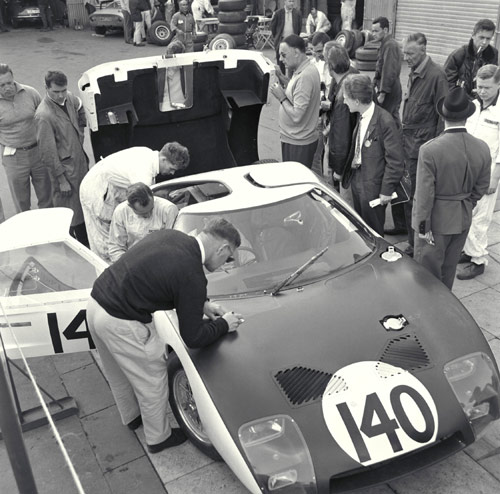
The changed nose during inspection at the Nuerburgring 1964 (Bruce
McLaren/Phil Hill car #102)
The GT46 road car study that was soon listed
as "discontinued"

A unique clay model design that never went into production
Let's hope Holly can finally finish her Scrap book of
what she found one day soon.
|




















